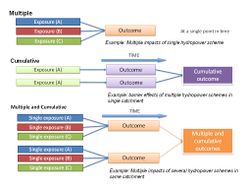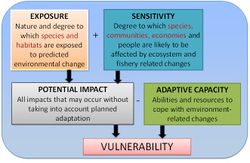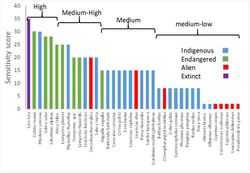Difference between revisions of "Cumulative impact assessment"
| Line 1: | Line 1: | ||
| − | [[file:Figure1CIA.jpg|thumb|250px|Figure 1. Illustrated definition of multiple, cumulative and multiple cumulative impacts ( | + | [[file:Figure1CIA.jpg|thumb|250px|Figure 1. Illustrated definition of multiple, cumulative and multiple cumulative impacts (UHULL)]] |
| − | [[file:Figure2CIA.jpg|thumb|250px|Figure 2. Scheme of vulnerability assessment in freshwater fishes ( | + | [[file:Figure2CIA.jpg|thumb|250px|Figure 2. Scheme of vulnerability assessment in freshwater fishes (UHULL).]] |
| − | [[file:Figure3CIA.jpg|thumb|250px|Figure 3: Relative sensitivity rankings of UK fishes - based on distribution, abundance and phenology ( | + | [[file:Figure3CIA.jpg|thumb|250px|Figure 3: Relative sensitivity rankings of UK fishes - based on distribution, abundance and phenology (UHULL).]] |
Despite concerns over cumulative and/or multiple environmental exposures/impacts, there is currently no standard definition of ‘cumulative’ or ‘multiple’ impacts, nor standard approaches for this type of assessment. The European Commission identified this problem in their Guide-lines for the Assessment of Indirect and Cumulative Impacts as well as Impact Interactions (European Commission 1999) by stating ‘a key problem … was how to define indirect and cumulative and impact interactions. The definitions of these three types of impact overlap, although there are no agreed and accepted definitions’ (European Commission 1999). In the Chambers English Dictionary, cumulative is defined as ‘increasing by successive additions’ and multiple as ‘consisting of many elements or components’ (Chambers English Dictionary, 7th Edition, Schwarz 1988). Thus technically “cumulative impacts” refers to a single exposure, repeated many times, while multiple implies more than one exposure, occurring once or re-peated many times (cumulative and multiple). These exposures may occur at low levels and only cause noticeable outcomes through their cumulative/multiple effects. | Despite concerns over cumulative and/or multiple environmental exposures/impacts, there is currently no standard definition of ‘cumulative’ or ‘multiple’ impacts, nor standard approaches for this type of assessment. The European Commission identified this problem in their Guide-lines for the Assessment of Indirect and Cumulative Impacts as well as Impact Interactions (European Commission 1999) by stating ‘a key problem … was how to define indirect and cumulative and impact interactions. The definitions of these three types of impact overlap, although there are no agreed and accepted definitions’ (European Commission 1999). In the Chambers English Dictionary, cumulative is defined as ‘increasing by successive additions’ and multiple as ‘consisting of many elements or components’ (Chambers English Dictionary, 7th Edition, Schwarz 1988). Thus technically “cumulative impacts” refers to a single exposure, repeated many times, while multiple implies more than one exposure, occurring once or re-peated many times (cumulative and multiple). These exposures may occur at low levels and only cause noticeable outcomes through their cumulative/multiple effects. | ||
Latest revision as of 10:53, 26 October 2020
Despite concerns over cumulative and/or multiple environmental exposures/impacts, there is currently no standard definition of ‘cumulative’ or ‘multiple’ impacts, nor standard approaches for this type of assessment. The European Commission identified this problem in their Guide-lines for the Assessment of Indirect and Cumulative Impacts as well as Impact Interactions (European Commission 1999) by stating ‘a key problem … was how to define indirect and cumulative and impact interactions. The definitions of these three types of impact overlap, although there are no agreed and accepted definitions’ (European Commission 1999). In the Chambers English Dictionary, cumulative is defined as ‘increasing by successive additions’ and multiple as ‘consisting of many elements or components’ (Chambers English Dictionary, 7th Edition, Schwarz 1988). Thus technically “cumulative impacts” refers to a single exposure, repeated many times, while multiple implies more than one exposure, occurring once or re-peated many times (cumulative and multiple). These exposures may occur at low levels and only cause noticeable outcomes through their cumulative/multiple effects. Figure 1 attempts to illustrate these explanations diagrammatically in the context of hydropower development, but are purely additive and do not include impact interactions, which are complex to interpret. Consequently, there is a need to draw on principles and thinking for other domains.
To understand the notion of cumulative impact on fish and fisheries, reference to the climate change literature is advised, where the concepts of vulnerability and exposure are discussed in relation to the impact of climate change on populations.
Climate risk analyses (and their predecessors, Climate Vulnerability Analyses) are a systematic comparison of the consequences of climate change and applicable for understanding the likely vulnerability and adaptability of climate change on fish conservation. The IPCC’s (2007) vulnerability assessment framework provides a mechanism to understand the vulnerability of freshwater fish and fisheries to climate change scenarios, and the process is equally applicable to understanding the impact to hydropower development on freshwater fish and fisheries. Exposure is related to direct effects of changes in connectivity, loss of recruitment, change in hydrology (duration, frequency and amplitude of the hydrograph) and sediment delivery or size of impoundment etc. on river ecosystems. Biological sensitivity can be derived from trait-based indicators related as outlined in the Fish Hazard Index (FIThydro deliverable D1.3 Fish Population Hazard Index) related to:
- ABUNDANCE -measures of potential for biological productivity
- DISTRIBUTION – measures of capacity to shift
- PHENOLOGY – measures of the potential impact on the timing of life cycle events.
Adaptive capacity in the context of fish conservation largely relates to mitigation measures that are linked to recovery potential, e.g. fish passage facilities, habitat improvement measures, establishing environmental flows, screening of turbine, or protecting habitats from degradation and maintaining the ecosystem integrity to support the aquatic biota (FIThydro deliverable D2.1: A List of solutions, models, tools and devices, their application range on a regional and overall level, the identified knowledge gaps and the recommendations to fill these). Stock enhancement is another measure that can be used but this does not take away the bottleneck to recruitment nor production processes that impact on the populations and is thus an unsustainable measure unless carried out in combination with other habitat-related measures.
Vulnerability applied in the context of hydropower development refers to the interplay of a freshwater fish’s exposure to projected impacts from the physical structure and change to the fish’s habitat (extrinsic factor), its sensitivity to the impacts factors (based on intrinsic traits) and ability to adapt (intrinsic traits).
Exposure is derived from the relative change to the aquatic, and thus fishes’, environment between the pre-hydropower installation and current characteristics with the hydropower in-stalled and operational. Sensitivity is determined through a review of published literature in addition to the use of the European database on species traits compiled in the Fish Hazard Index. Attributes are related to the historical distribution of the species and their relative abundance, as well as the IUCN Red List in terms of conservation status. These are coupled with phenological traits that likely impact on the timing of life cycle events. These traits included maximum size (Lmax), von Bertalanffy growth coefficient (k), age at 50% maturity (tmat), size at 50% maturity (Lmat), reproductive strategy (R), fecundity (F) and trophic level (TL). For each species, each exposure and sensitivity attribute can be scored on a Likert scale (say 1–3, where 1 indicates low exposure and low sensitivity and 3 indicates high exposure and high sensitivity). The sensitivity score for each species present can then be represented graphically on a stacked bar chart to illustrate the most vulnerable species and thus those that require the most focussed action. These tend to be migratory species (both diadromous and potamodromous species) that need to bypass the hydropower installation both in and upstream and downstream direction. An example of the vulnerability assessment for UK freshwater species is illustrated in Figure 3.
The most sensitive species are those that are migratory, such as salmon (Salmo salar) and shads (Alosa spp.), or have very limited distribution ranges such as spined loach (Cobitis taenia) or limited environmental tolerances, e.g. grayling (Thymallus thymallus). Worryingly, the low risk species are mostly non-native invasive that are considered problematic in the UK and considerable investment has been spent eradicating sunbleak (Leucaspius delineates) and top-mouth gudgeon (Pseudorasbora parva). Opening up fish passage will likely exacerbate the spread of these species and require increased investment to control. The medium sensitivity species are all eurytopic species with 3-10 year life cycles and wide distribution.


